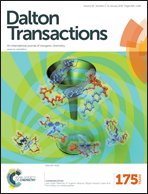Interesting copper(ii)-assisted transformations of 2-acetylpyridine and 2-benzoylpyridine†
Abstract
The reactions of various copper(II) sources with 2-acetylpyridine, (py)(me)CO, and 2-benzoylpyridine, (py)(ph)CO, under strongly basic conditions have been studied and novel ligand transformations have been discovered. Reaction of Cu(ClO4)2·6H2O and (py)(me)CO in the presence of NBu4nOMe (1 : 1 : 1) in CHCl3 gave a mixture of [Cu2Cl2(HLA)2](ClO4)2 (1) and [Cu2Cl2(LB)2(ClO4)2] (2), where HLA is 3-hydroxy-1,3-di(pyridin-2-yl)-butane-1-one and LB is the zwitterionic-type ligand 3-hydroxy-1-methyl-3-(pyridin-2-yl)-3H-indolizin-4-ium. The ligand HLA is formed through an aldol reaction-type mechanism, while the formation of LB takes place via an intramolecular nucleophilic attack of the remote 2-pyridyl nitrogen atom on the positive carbonyl carbon of HLA, after the transformation of the latter through deprotonation and dehydration. The CuII ions in 1 are bridged by two 2.1111 HLA ligands resulting in a long CuII⋯CuII distance (5.338 Å); the metal ions in 2 are triply bridged by the alkoxide oxygen atoms of the two 2.21 LB ligands and one 2.1100 perchlorato group. The absence of α-hydrogens in (py)(ph)CO leads the reactivity of this ligand in the presence of CuII to different pathways. The Cu(ClO4)2·6H2O/(py)(ph)CO/NBu4nOMe reaction mixture in MeOH/H2O (25 : 1 v/v) gave the dinuclear cationic complex [Cu2{(py)(ph)CO}2(LC)2](ClO4)2 (3), where LC− is the anion of (methoxy)(phenyl)(pyridin-2-yl)methanol formed in situ via the nucleophilic addition of MeO− to the carbonyl carbon of (py)(ph)CO upon CuII coordination. The CuII ions in the cation are doubly bridged by the deprotonated oxygen atoms of the two LC− ligands. Replacement of Cu(ClO4)2·6H2O with Cu(NO3)2·3H2O and NBu4nOMe with NMe4OH and the decrease of the H2O concentration in the above reaction system yielded the tetranuclear coordination cluster [Cu4(OMe)2(NO3)4{(py)(ph)CO}2(LC)2] (4). The CuII centres in this complex define a parallelogram. Two parallel sides of the parallelogram are each supported by deprotonated oxygen atoms belonging to a 2.21 LC− ligand and a 2.2 MeO− group. The metal ions that define each of the other two sides are singly bridged by an oxygen atom of a 2.210 nitrato group. No bridging exists between the CuII ions that define the two diagonals of the parallelogram. Replacement of MeOH with EtOH in the reaction system that gave 4 resulted in the dinuclear complex [Cu2(NO3)2(LD)2)(EtOH)] (5), LD− being the anion of (ethoxy)(phenyl)(pyridin-2-yl)methanol. The CuII ions are doubly bridged by the alkoxide oxygen atoms of the two 2.21 LD− ligands. The 1 : 1 : 1 Cu(NO3)2·3H2O/(py)(ph)CO/NMe4OH reaction system in CH3NO2 gave the dinuclear complex [Cu2(NO3)2(LE)2] (6), where LE− is the anion of 2-nitro-1-phenyl-1-(pyridin-2-yl)ethanol. The OH− ion abstracts one of the methyl hydrogens of CH3NO2, and once the carbanion −:CH2NO2 is formed it attacks the positive (δ+) carbonyl carbon of (py)(ph)CO; as the carbanion forms the new C–C bond, the π electrons of the carbonyl group of the original ligand are transferred completely to oxygen forming the alkoxide-type ligand LE−. The CuII ions are doubly bridged by the alkoxide oxygen atoms of the two 2.21 LE− ligands. Simplified mechanistic views of the CuII-assisted formation of the transformed ligands are proposed. Dc magnetic susceptibility studies in the 2–300 K range for the representative complexes 3–6 reveal the presence of very strong antiferromagnetic CuII⋯CuII exchange interactions in the dinuclear complexes 3, 5, and 6 and within the dimeric {Cu2(OMe)(NO3){(py)(ph)CO}(LC)}+ subunits of 4. The strong antiferromagnetic coupling is discussed in terms of the large Cu–O–Cu angles (101.0–102.9°) in the dinuclear, planar {Cu2O2} units/subunits of 3–6.


 Please wait while we load your content...
Please wait while we load your content...